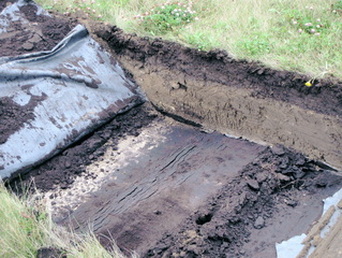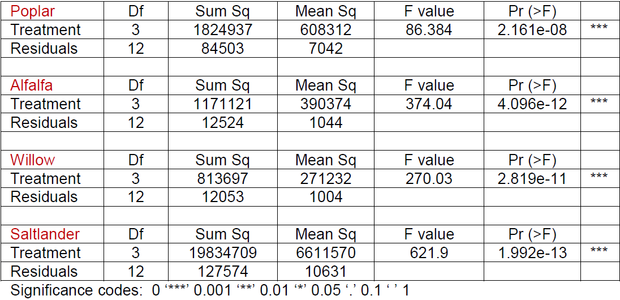Plant-assisted remediation of nitrogen fertilizer contaminated soil and groundwater at an industrial plant site
Results
Results of the ANOVA for each plant type are presented in Table 2. Based on the resulting p-values, there was a significant change in ammonium nitrate concentration in all four plant types. Results of the Tukey pairwise comparison test, as illustrated in Table 3, indicate a significant difference in change in ammonium nitrate concentration for the 4000 ppm (high) and 1000 ppm (medium) treatments when compared to the control for all four plant types studied. There is not a significant difference in change in ammonium nitrate concentration for the 100 ppm (low) treatment for any of the four plant types based on this ana.
Table 2. Results of Analysis of Variance illustrating significance of change in ammonium nitrate
concentration for Okanese poplar, alfalfa, willow and Saltlander grass.
Table 3. Results of Tukey pairwise comparison illustrating significance of change in ammonium
nitrate concentration for each treatment level for Okanese poplar, alfalfa, willow and
Saltlander grass. Highlighted values indicate comparison of each treatment level with the
control.
Discussion
Results of the statistical analysis indicate a significant change in ammonium nitrate concentration for all treatment levels and for all plant types. However, one of the objectives of this experiment, as requested by Agrium, was to have vegetation that would not only take up excess soil nitrogen, but also thrive in the field with minimal maintenance. Although all four plant types showed a significant change in ammonium nitrate when exposed to high initial contamination levels (4000 ppm), only the Saltlander grass survived for the duration of the experiment. The remaining plant types, Okanese poplar, willow and alfalfa, survived for approximately two weeks in the highly contaminanted soil. While these plant types extracted enough soil ammonium nitrate in the two weeks to result in a significant change, because they did not survive for the duration of the experiment, they are not considered to be vegetation types successful in the remediation of nitrate contaminated soils at levels up to 4000 ppm. Based on significant change in soil ammonium nitrate levels and successful growth, Saltlander grass is the best choice as a vegetation type for plant-assisted remediation of nitrogen contaminated soils. In soils contaminanted with 100 and 1000 ppm of ammonium nitrogen Saltlander grass, Okanese poplar, willow and alfalfa are all good choices for plant-assisted remediation.
Future Research

Based on the results of Trial 1, a further growth chamber experiment will be completed using actual contaminated soil from the nitrate fines landfill. Because three of the four plant types did not survive in soils contaminated with 4000 ppm of ammonium nitrate, the second experiment will be carried out with 2500 ppm as the highest treatment level. The purpose of this experiment is to try to determine the upper limit of plant nitrogen tolerance, and to determine if the three unsuccessful plant types from Trial 1 will be more resilient in soils with a lower initial level of contamination.


